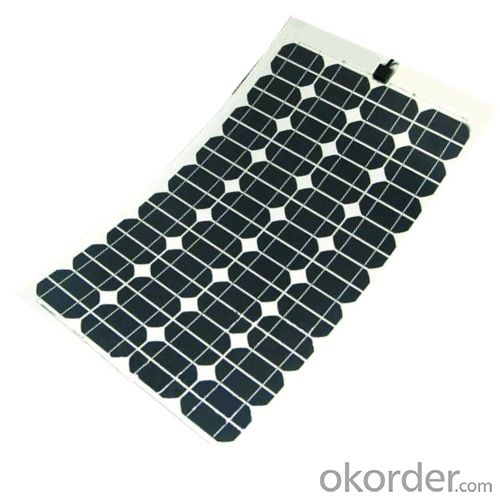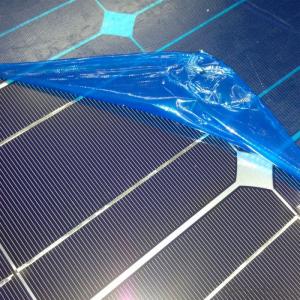12V Flexible Solar Panel with New Designed for China Manufacturers
- Loading Port:
- Shanghai
- Payment Terms:
- TT OR LC
- Min Order Qty:
- 1000 watt
- Supply Capability:
- 10000 watt/month
OKorder Service Pledge
OKorder Financial Service
You Might Also Like
Item specifice
Product Description

New designed flexible solar panel 12v for China Manufacturers
Flexible solar panel are designed to provide a powerful charging solution for batteries and conform to almost any surface. Unlike other 'flexible' products, these use high-efficiency monocrystalline cells that produce more power per square foot than any other flexible panel on the market.
An impermeable lamination coats the entire module, allowing it to contour and flex against curved areas, eliminating any need for custom mounts.
The panel can be affixed by adhesive or screw mounting options and grommets are an added bonus for ease-of-installation. The thin, lightweight module can also be sewn into canvas, making it a truly versatile solar module.
The Solar Flex panels are aerodynamic and DURABLE - a virtually unbreakable solar battery charger for RVs, boats and long-haul trucks.
Why Choose Us:
1). Professional Manufacturers Of Mono & Poly Silicon PV Module
2). High Conversion Efficiency Solar Module
3). High transmission rate and low iron tempered glass
4). Anti-aging EVA, high frame resistant TPT to laminate and anodized aluminum alloy frame
5). Be resistant to atmospheric exposure and effects of delaminating
6). Strict quality control and power classification of modules
7). Full passport certificate ISO9001, ISO1400, OHSAS18001, CE, TUV IEC/EN61215 IEC/EN61730
8). 25years Warranty, 90% of original efficiency in 10years, and 80% in 25years.
WHY US?
1. We have our own production line of solar cells.
2. Our solar panels are good quality with OEM service.
Our products are backed by an industry standard 5/10/25 warranty to assure the longevitiy of your system. Not only this, we assure the quality of our modules with 100% infrared scanning to go with our standard quality assurance procedures. Depending on the availability by your location, we may also be able to offer liability insurance coverage for our products.
| Module size (mm): | 535*1050 |
| Cell Type | 125x125 |
| Weight(kg) | 3 |
| Power tolerance: | +/-3% |
| Nominal peak power(WP): | 100 |
| Nominal voltage(V): | 17.6 |
| Nominal current (A): | 5.68 |
| NOCT: | 45+/-2°C |
| Voltage temperature coefficient: | -0.33%/°C |
| Current temperature coefficient: | +0.05%/°C |
| Power temperature coefficient: | -0.23%/°C |
| Open circuit voltage (Voc): | 20.8 |
| Short cirsuit current(Isc): | 6.14 |
| Conversion efficiency: | 20.41% |
| Operating temperature: | -40 to+85°C |
| Max system voltage: | 1000V DC |
- Q:How efficient are the solar panels....?
- DS's solar panels convert 22% of their available energy into electrical power. This may not sound very good, but it is much better than most solar panels. Most solar panels on people's houses, for example, are fairly inefficient. Less than 4% of the energy that reaches them will be converted to electricity. DS's panels are so efficient, in fact, that unless the ion propulsion drive is running, DS is producing far more power than it needs.
- Q:How can I calculate the amount of watts needed for a solar panel to power a water and air pump in gal/hr and a 600 watt LED light?
- Mimi: Solar Power is not really that economical, and has many other disadvantages as well. You did not specify much info in your question as to the size of the water or air pump. So let's make some assumptions to get you some numbers. ) Let's say the water and air pump are about HorsePower (HP). The HP pump , considering efficiency losses, will draw around ,000 Watts , or kW. 2) The 600 Watt LED Light is quite high --- they are usually much smaller lights 40 Watts or less. BTW --- these LED lights are very expensive light as well. Just so you are aware. Between the pump(s) ( maybe 000 to 400 Watts) and the 600 Watt light ----- and without knowing the specifics --- you are probably looking at around 2,000 Watts or 2 kW. A 2 kW Solar PV unit will run around $20,000. The PV unit will only run at full capacity during daylight hours. They usually average about 5 hours per day. So you will only be able to run your pump and LED Lights during the middle of the day --- maybe 0:00 AM to 5:00 PM. If you want to run the pump and lights after sundown, you will need battery back-up. The electric storage batteries will likely run about an extra $5,000. They will last about 5 years. If you decide this doesn't work out well --- you can stay with the local utility --- at $0.0 per kWh. It will cost you about $0.0 per hour to run the pump --- maybe 30 to 50 cents per day. It would cost you about 6 cents per hour to run your light. Maybe 30 or 40 cents per day. You could essentially run your pumps and light several hours each day --- all for about $ per day, or $365 per year. This sounds like a less costly alternative.
- Q:Can solar panels be installed on a sports stadium?
- Yes, solar panels can be installed on a sports stadium. In fact, many stadiums around the world have already adopted solar energy systems to generate electricity and reduce their carbon footprint. These panels are typically installed on the roof or in parking lots surrounding the stadium, taking advantage of the large surface area available. Installing solar panels on a sports stadium not only helps in generating clean energy but also serves as a visible statement of the stadium's commitment to sustainability.
- Q:If this was sold back to the grids what would be the profit i would stand to make per day on energy received in these panels? How did you come up with this answer?
- Considering capital outlays, such a system might never recover its initial investment. That's why we don't see such small photovoltaic plants popping up around the country - the economic case isn't there. One of the problems is that you would have to sell your electricity wholesale, at a ridiculously low price like 2 cents / kWh. If you were displacing electricity that you would otherwise use, then the financial case is different. Retail electricity could be 20 cents / kWh, 0 times as much, and you could get your money back over time, and start to make a profit. I've assumed you're in the US, with no special feed-in tarrifs. If you're in a country with a premium rate for solar-generated electricity, the business case could be very different.
- Q:I know what they do and how they work, but at this point they're expensive, don't always produce enough electricity as needed, and can't be used when there's no sun, as in half the day. Wouldn't wind power seem so more efficient? Or if they do use solar panels, how about putting them in the desert. But I really believe that research money should go to fusion generators since that's the future and the answer to our problems. Which is best in your opinion?
- i think that they are effective, even tho they cost heaps to get installed, i think that they are worth it. They dont require any effort to operate and use natural sunlight that turns into energy that people use everyday. they may be an eye sore but think of how much they are helping the earth and they are a great alternitave to fossil fuels (which are running out anyway), the only problem that i think they would have would be in winter when there isnt much sun on a few days. but other than that they are great
- Q:I'm trying to charge rechargeable AA batteries with a solar panel. What gauge wire should I use to connect the panel to the batteries? I know I'm not going to have a lot of current going through so the wire size doesn't really matter. Can the wire be too thick thoShould I ugh? Should I use a diode to keep the batteries from overpowering the circuit? If so, what size diode? My panel is 4.8V 50mA. Can I just hook the panel straight into the batteries or do I need something else?
- In order: .? Just about any wire will do.? You can handle 50 mA over just about anything, even 28 gauge telephone wire.? Your biggest problems are probably going to be mechanical stress (you want stranded wire instead of solid, to avoid breakage) and dealing with the size of larger wires. 8 gauge speaker wire may be a good optimum. 2.? You need a diode.? If you're charging NiMH or NiCd cells you're going to have about .25 volts/cell; you can charge up to 3 of them in series with a 4.8 volt panel.? The solar panel is a bunch of diodes itself, but they're leaky in the reverse direction; the diode prevents the batteries from discharging themselves back through the panel.? You want a Schottky-barrier diode, because the forward voltage drop is about 0.2 volts instead of 0.7 volts for a regular silicon rectifier.? This gives you maximum current output from your panel.
- Q:Can solar panels be used for powering traffic lights?
- Yes, solar panels can be used to power traffic lights. They are a reliable and sustainable energy source that can effectively generate electricity to operate the lights.
- Q:How do I hook up solar panels to my home
- Seriously, the best way to get an idea of what it takes is to call up a solar installer and get a free quote for your home. It costs you nothing, except your time. If there are no installers in your area, you may be in a bad location for solar.
- Q:How do solar panels affect the property's carbon footprint?
- Solar panels can significantly reduce a property's carbon footprint as they harness clean and renewable energy from the sun. By generating electricity without emitting greenhouse gases, solar panels help to offset the carbon emissions that would otherwise be produced by using traditional fossil fuel-based energy sources. This reduction in carbon footprint contributes to a more sustainable and environmentally friendly property.
- Q:Can solar panels be installed on an RV or camper?
- Yes, solar panels can be installed on an RV or camper. In fact, many people choose to install solar panels on their recreational vehicles to harness renewable energy and reduce reliance on traditional power sources while on the road. Solar panels can provide a sustainable and efficient way to charge batteries, power appliances, and even run electrical systems in an RV or camper.
1. Manufacturer Overview |
|
|---|---|
| Location | |
| Year Established | |
| Annual Output Value | |
| Main Markets | |
| Company Certifications | |
2. Manufacturer Certificates |
|
|---|---|
| a) Certification Name | |
| Range | |
| Reference | |
| Validity Period | |
3. Manufacturer Capability |
|
|---|---|
| a)Trade Capacity | |
| Nearest Port | |
| Export Percentage | |
| No.of Employees in Trade Department | |
| Language Spoken: | |
| b)Factory Information | |
| Factory Size: | |
| No. of Production Lines | |
| Contract Manufacturing | |
| Product Price Range | |
Send your message to us
12V Flexible Solar Panel with New Designed for China Manufacturers
- Loading Port:
- Shanghai
- Payment Terms:
- TT OR LC
- Min Order Qty:
- 1000 watt
- Supply Capability:
- 10000 watt/month
OKorder Service Pledge
OKorder Financial Service
Similar products
New products
Hot products
Hot Searches
Related keywords






























